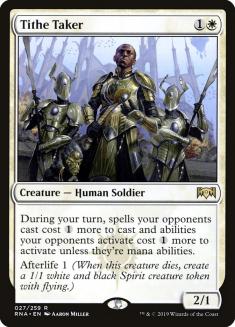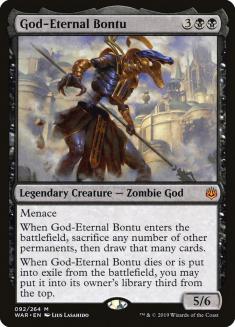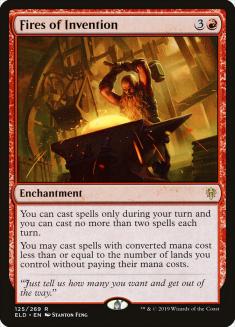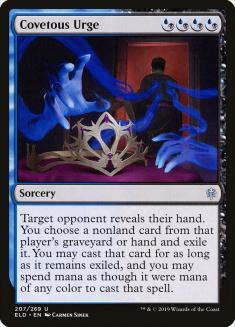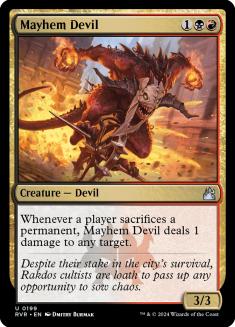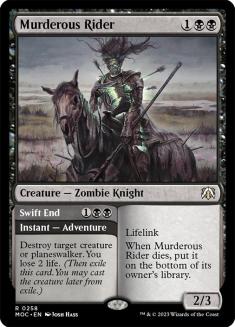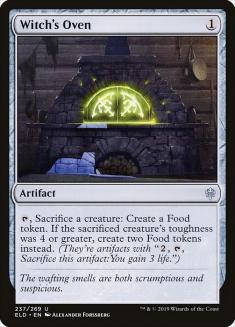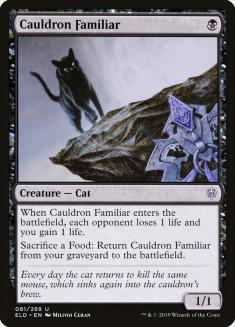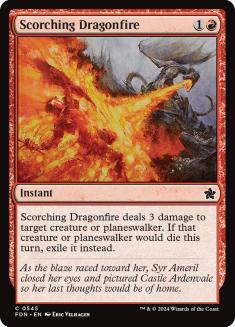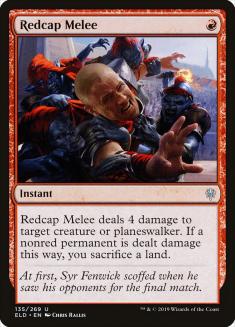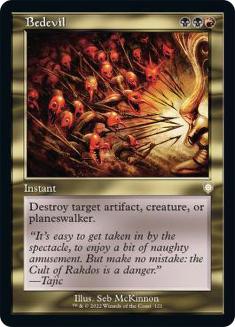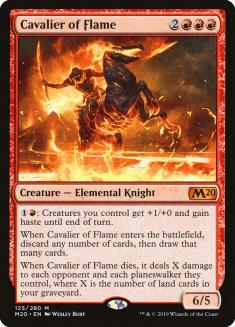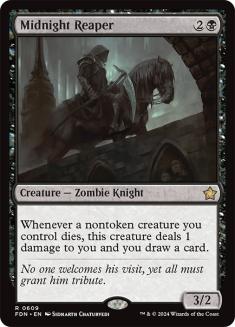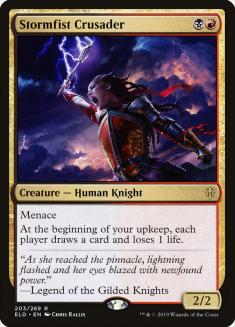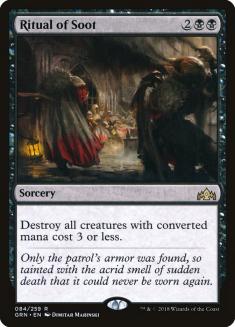As you probably already know by now, I played the Jeskai Fires deck I wrote about last week to a Top 8 finish in Mythic Championship VII. Today, I will write about the other Fires deck I very nearly played at the tournament: Rakdos Fires.
Before I do that, though, I wanted to give you some updates on Jeskai Fires. First, I realized that my sideboard plan for the mirror wasn’t optimal, especially if they had Legion Warboss. Having four Mystical Disputes means they were stuck in my hand too much in a match where I could either have Fires of Invention on the battlefield or my opponents could have Teferi, Time Raveler, and six answers to Legion Warboss wasn’t a big enough number on the draw. Against Warboss decks, I now leave in at least two Bonecrusher Giants in my deck, and remove two Mystical Disputes.
The second update is the inclusion of Tithe Taker. When we were building our deck for Mythic Championship VII, we assumed very few people played Flash; I thought Izzet Flash wasn’t a very powerful deck (and also not even a very bad matchup), and the current build of Simic Flash didn’t exist. As such, I didn’t think we needed something specific for that matchup. Now that the deck is popular, you probably want to play Tithe Taker, which is what some members of the GP Brisbane Top 8 did. I would probably play at least three of them, possibly four, cutting the Drawn from Dreams and the two Devout Decrees, as well as potentially another removal spell or Disenchant.
A lot of people have asked me if I think the Jeskai Fires deck is still good. I think the deck is still powerful and certainly playable, but whether it’s a great deck or something I’d try to move away from will strongly depend on the direction the metagame takes. If everyone adopts the Simic Flash deck, I would probably look to play something else; if people adopt aggro decks to beat Simic Flash (or Adventures, or Jund Sacrifice), I think the deck will be very good.
And now, the deck I almost played at Mythic Championship VII:
Creatures (26)
- 4 Midnight Reaper
- 4 Mayhem Devil
- 4 God-Eternal Bontu
- 4 Cavalier of Flame
- 2 Murderous Rider
- 4 Cauldron Familiar
- 4 Stormfist Crusader
Lands (24)
Spells (10)
Sideboard

This deck was originally created by Ben Weitz, who had an insane MTG Arena record with it before submitting it to us for “internal testing” for Mythic Championship VII. We then played it a lot amongst ourselves and felt that, while it was a good deck, we weren’t confident enough in it to deviate from the more standard and already proven to be very powerful Jeskai Fires deck. In the end, only John Rolf played it (albeit a slightly different version); Siggy, Matt Nass, and I all opted for Jeskai Fires. John didn’t do well at the tournament, but I still think this deck is a very cool option if you’re looking for something different in Throne of Eldraine Standard, and it’s certainly much better than it looks, even if it’s probably not as good as Jeskai Fires for most metagames.
Even though they’re both decks that try to cast Fires of Invention into five-drops, this deck operates fundamentally differently from Jeskai Fires. Jeskai Fires is all about finding and playing Fires of Invention; the entire deck is designed to do that. This deck is not as good at finding Fires of Invention, but it also has a much more real gameplan when it doesn’t have it, since it can just beat down to some extent. When you spend your entire first three turns setting up Fires of Invention and then you either don’t find it or it’s dealt with, it’s a very different scenario from when you spend your first turns casting creatures.
This deck is also much, much more complicated to play than Jeskai Fires. Jeskai Fires has trivial gameplay, as it tries to do the same thing every time and the thing it’s doing is not that complex; it just attacks for as much damage as it can. Rakdos Fires, on the other hand, is both capable of doing more things (you have several different gameplans and need to choose which one you commit to) and is also doing something very complex. Instead of being just “resolve your Cavaliers and attack,” you have to do a lot of math, decide what you should sacrifice and what you should keep, calculate the odds of drawing a specific card, and basically do everything in your power to squeeze in the last points of damage. On top of that, with Jeskai Fires, if you miscount, you simply kill them next turn; with this deck, if you mess up or realize in the middle of the “combo” that you’re short, you might find yourself with no lands on the battlefield for next turn. A lot of the people who look at this deck and think “Oh wow, what a pile of random cards” simply do not understand how the deck operates and what it is capable of.
The benefit of that is that it’s also very hard to play against. If you don’t know for sure how much damage you’re capable of dealing, there’s certainly no way your opponent is going to know, especially if they aren’t familiar with the decklist. Against Jeskai Fires, it’s easy to see what the maximum amount of damage you can take in one turn is and then go from there: if they have six lands and Fires of Invention on the battlefield, for example, the maximum they can deal is eighteen (twelve from attacks from two Cavalier of Flame and six from pumps). This deck can easily deal twenty with the same configuration, so people often just attack you and put themselves dead, but at the same time they can’t know, so they sometimes don’t attack you and give you more time to establish your combo.
Here are some interesting things about it how the deck plays out:
- The most “broken” play in the deck is casting God-Eternal Bontu as your second free spell of the turn and then sacrificing Fires of Invention, which frees up all your mana to cast a third (or fourth or fifth) spell that turn, which happens to be quite common when you’ve just drawn a bunch of extra cards. This is the reason this deck doesn’t have an easily identifiable upper limit of damage like the Jeskai version does.
- Between Cauldron Familiar, Mayhem Devil, Stormfist Crusader, Cavalier of Flame triggers, and just random attacks, the deck deals a lot of chip damage over the course of the game, and this chip damage is very important. You often can’t deal the full twenty in a combo turn, but you don’t have to because they’re not at twenty. A lot of the time you start doing complex math to see what you need to draw and then you realize, “Wait, if I just sacrifice all my permanents they are dead,” or “If I just pump my creatures with Cavalier then they won’t be able to block these menace ones and that’ll be enough damage.” Both God-Eternal Bontu and Stormfist Crusader having menace makes it hard for most decks to block a large portion of the attack damage.
- You can cast God-Eternal Bontu, stack its ability, and then sacrifice the Bontu itself to Witch’s Oven to get two Foods, which you can then sacrifice for the Bontu ability. You can even put the Bontu back on top at that point to draw it again.
- Mayhem Devil and God-Eternal Bontu are a powerful combo. If you have both of them on the battlefield, you can deal one damage per permanent you control.
- Bontu and Cavalier of Flame are also a combo: if you cast Bontu, you can sacrifice all your lands and the Cavalier at the same time to deal them one damage per land.
- Cavalier of Flame triggers in this deck can get huge, as you have a lot of card drawing and go through your deck very quickly. In Jeskai Fires, the trigger is almost trinket text and hits them for two or three damage, but here it often ends the game even if you don’t necessarily combo it with Bontu sacrificing all your lands. As a general rule, this deck will go over the top of anyone in the late-game, since it can easily kill without having to attack and without relying on any creature surviving by simply chaining a bunch of Cavaliers.
- You can discard Cauldron Familiar to Cavalier of Flame for a surprise burst of damage, since you bring the Familiars back for free and then they get the haste and pump from the Cavalier.
- This deck puts extra Food or extra Cauldron Familiars to good use, since it can just sacrifice them to God-Eternal Bontu. This means that the Cat/Oven combo pieces can still be useful in the deck even if you only draw one half of the combo (but if you draw both you obviously get the Midnight Reaper and Mayhem Devil synergies).
Sideboarding
Sideboarding is, as always, contextual. The big decision point for how your deck should look like is whether you expect a lot of Jeskai Fires or not. If you do, I think playing Covetous Urge makes sense. Covetous Urge extracts a price in every match (you need to play Steam Vents in your maindeck), but it’s truly an incredible card versus Jeskai Fires that swings the matchup completely: you can either steal their Fires of Invention and then cast it, or you can steal their Cavalier. There aren’t many aggro decks in this format that will punish you for taking two extra damage in a game, but of course you need to adjust if there are.
The rest of the sideboarding is mostly dedicated to improving your matchup versus aggro decks and giving you additional ways of killing Mayhem Devil. Embercleave, in particular, is a big problem that doesn’t have a great solution; the best card for the job is Bedevil but there’s not much past that, and the deck is already full of three-mana cards. At some point during testing we played Bedevil in the maindeck, but now that there are few Embercleave decks I think Murderous Rider is better (but this is also a swap you can make depending on what metagame you expect).
Past that, there’s usually not much to sideboard out, since the deck is so cohesive. I end up just taking out a copy of what I consider to be the worst card in each matchup, and that’s usually a Cauldron Familiar or Witch’s Oven, since games are slower and grindier after sideboarding and you can’t afford to draw too many copies of one of those, but sideboarding is usually minimal versus decks that aren’t in the extremes of the spectrum.
VS Jeskai Fires
Out:
In:
I believe this matchup is unfavored without Covetous Urge but slightly favored with the current plan. They are much better at finding Fires of Invention, but they are worse at winning without it, and if you both have it, you usually go over the top of them (especially with Covetous Urge). This creates a scenario in which you usually win the games where both players have Fires or the games where no player has Fires, but the ones where they have Fires and you don’t are more common than the reverse.
VS Golgari Sacrifice
Out:
In:
This matchup is good for you, as they are neither aggressive nor particularly disruptive. Casualties of War is their best card, so make sure you try to not get blown out by it (which sometimes includes simply not playing your Fires of Invention). If you can snipe it with Covetous Urge, that’s generally the best target.
VS Jund Sacrifice
Out:
In:
This is a much harder matchup because Mayhem Devil is a very good card against you. Because of this, you need to not only keep the maindeck removal but also sideboard in additional removal, even though you don’t really want removal against the rest of their deck. Jund is a close matchup but if they understand what is going on in the games, I think it’s unfavored.
VS Golgari Adventures with Lucky Clover
Out:
In:
VS Golgari Adventures with Rotting Regisaur
Out:
In:
This is a good matchup, because Mayhem Devil is incredible versus them and you can also just go over the top of anything they do, so you sort of win both the early- and the late-game. If they are the Lucky Clover version, you don’t need Murderous Rider, but if they have Rotting Regisaur and The Great Henge, I think you want the ability to kill these cards, as an early The Great Henge or Rotting Regisaur backed up by Vivien, Arkbow Ranger are some of their best ways to win.
VS Aggro decks
Out:
In:
Aggro decks change in composition but this is the general idea (be sure to include the Redcap Melee if they are heavy red, for example). You don’t need to go very hard on the Fires combos, since you morph into a more controlling deck for Games 2 and 3. We had Ritual of Soot as our card of choice because it killed Rotting Regisaur alongside all the Knights, but if people play a lot of Spawn of Mayhem, the card gets worse. Aggro decks in general are bad matchups if they have Embercleave (which most do), and these are the matchups where the Covetous Urge splash hurts you the most.
VS Simic Flash
Out:
In:
I have only played this matchup once, so my sideboarding could be way off. My impression is that you need to go under them to win, so I like keeping in all my cheap cards and sideboarding out some of the expensive pieces, but it’s possible this is going too far.
Overall this is a fun and challenging deck, and if you’re looking for something different I recommend you try picking it up. Just be aware that it really is complicated to play and you will probably not extract the most from it in your first couple of games, but once you’re familiar with all the interactions the deck has, you’ll probably have a blast playing it and killing your opponent out of nowhere.

